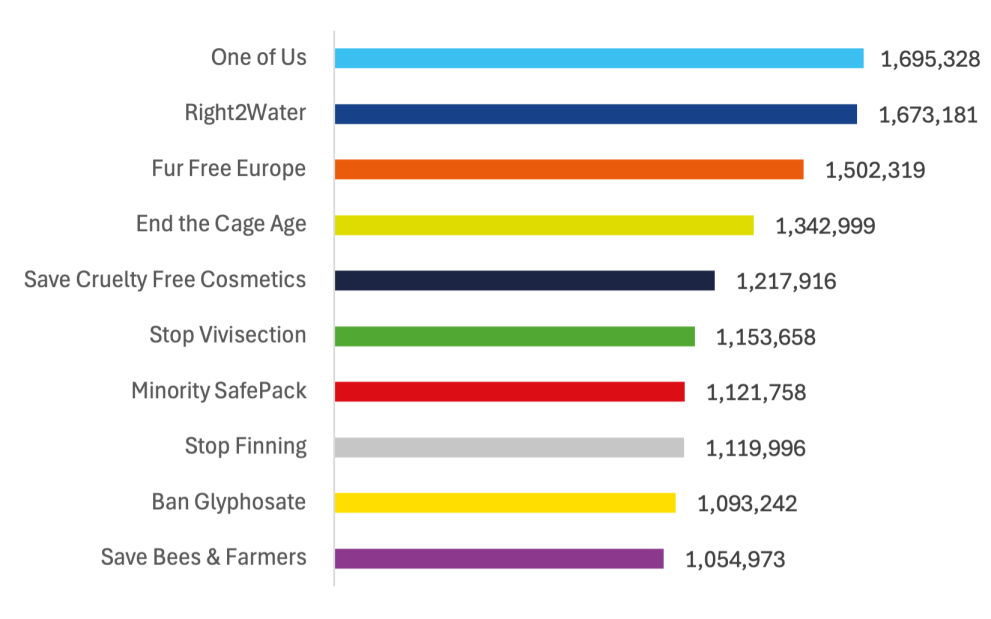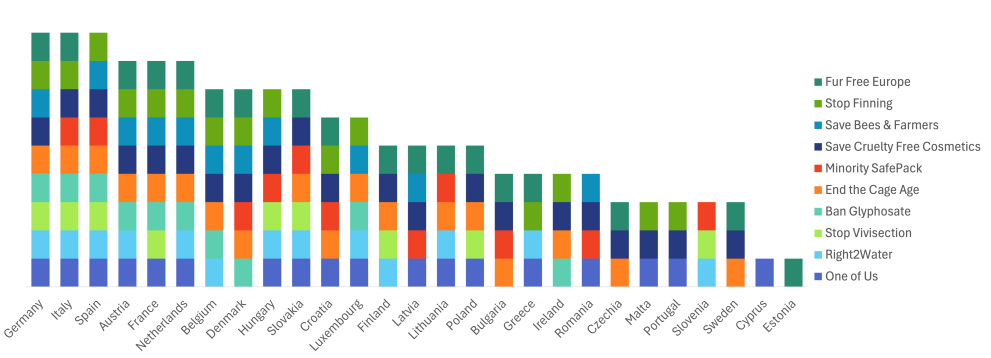The newly published European Citizens’ Initiative Infographic for 2024 provides a comprehensive statistical overview and key insights from the various European citizens’ initiatives (ECIs) registered since 2012, including demographic details about their organisers and supporters. Produced annually by the ECI Forum team, this infographic serves as a valuable resource for understanding trends in European citizens’ initiatives. It offers data-driven insights that can inform strategies for the success of future ECIs.
Successful ECIs collected almost 13 million signatures
With 10 successful ECIs as of 2024 – one more than last year – it is clear that collective citizen action is more important than ever. The data on signatures collected by these 10 successful initiatives reveals important patterns in the distribution and engagement across different Member States.
Among the successful initiatives, "One of Us" collected the highest number of verified signatures, totalling 1,695,328, followed closely by "Right2Water" with 1,673,181 signatures. The most recent successful initiative, “Fur Free Europe,” comes in third place with 1,502,319 signatures. This demonstrates significant public support for diverse causes, from pro-life advocacy to environmental and animal rights.
Figure 1. Total number of verified signatures collected by 10 successful ECIs (2012-2024)
Germany reported the highest number of signatures overall, while Malta had the highest per capita engagement
Germany reported the highest number of signatures overall, with more than 4.47 million signatures, far exceeding any other country. Italy followed with over 1.9 million signatures, and France with almost 1.1 million signatures. This high level of engagement in Germany, Italy, and France indicates these countries as strategic locations for large-scale campaigns due to their large populations and strong civic participation. Initiatives such as “Stop Glyphosate” and “Right2Water” benefitted from extensive networks in these countries, leveraging existing public awareness and advocacy structures to maximise their reach.
In contrast, smaller states like Cyprus and Estonia show much lower numbers, with 14,462 and 22,368 signatures, respectively, which is expected given their smaller populations. However, when considering signatures relative to Member State populations, Malta stands out with 8.9% of its population participating, the highest per capita engagement among all Member States. The “One of Us” initiative was particularly successful in Malta, collecting 23,017 signatures, nearly 48% of all signatures collected by successful initiatives in Malta. Hungary follows with 7.2% per capita engagement, driven significantly by the “Minority SafePack” initiative, which collected 527,686 signatures, accounting for about 76% of signatures for all successful initiatives in Hungary. These figures suggest that smaller countries, despite their population size, can achieve high levels of engagement through effective mobilisation and targeted campaigning.
Conversely, countries like Ireland, which have both low absolute numbers of signatures and low per capita engagement, may indicate some challenges faced by organisers. This could include a lack of awareness about the European Citizens’ Initiative or insufficient targeted campaigning. Understanding and addressing these underlying causes is crucial for future initiatives aiming to mobilise support more effectively in countries with low engagement with the ECI. Despite its large absolute numbers of signatures, France shows a relatively low per capita engagement at 1.5%, suggesting a need for more targeted and relatable campaign strategies.
Besides collecting at least one million signatures, European citizens’ initiatives must also reach a minimum number of signatures in at least seven Member States to be considered successful. The distribution of signature thresholds met by each initiative highlights the widespread support some initiatives garnered, as shown in the chart below. For instance, "Save Cruelty Free Cosmetics" achieved the highest number of thresholds, meeting the minimum number of signatures in 21 Member States. "One of Us," "End the Cage Age," and "Fur Free Europe" each met thresholds in 18 Member States.
Figure 2. Successful ECIs that reached the signature threshold in each Member State (2012-2024)
Thresholds were most frequently met in Germany, Italy and Spain, with each reaching thresholds in 9 out of the 10 successful ECIs. This consistency suggests targeted campaigns by the organisers in these countries. For instance, "One of Us" focused on countries with established pro-life movements, such as Germany, Poland, Spain, Malta and Italy, ensuring that the campaign resonated with the existing values and beliefs of the local populations. Besides targeting countries where it was easiest to collect signatures, the “Right2Water” initiative also tried to collect a minimum of 5% over the threshold when they reached the threshold in a country to make their initiative a success.
Conversely, in 15 Member States, the number of ECIs that reached the threshold was five or fewer. Reasons for that would require further research, but one possible reason could be that organisers tend to select a limited number of countries to lead their campaign.
Funding is crucial, but a strong campaign strategy can ensure the success of your ECI regardless
Successful ECIs like "Save Cruelty Free Cosmetics" and "Fur Free Europe" have received substantial funding, as depicted in the chart below. In contrast, initiatives such as "Stop Vivisection" and "Stop Finning" have operated on smaller budgets. Yet, the data reveals that financial resources, while beneficial, do not singularly determine success. Initiatives like "Stop Vivisection" have proven that a well-planned campaign—featuring effective messaging, a broad volunteer network, and extensive use of social media—can compensate for limited funding and still gather one million signatures.
The effectiveness of a campaign often hinges on the resonance of its message with the public and the ability to mobilise volunteers and supporters. Initiatives addressing universally relatable issues, such as animal rights or environmental protection, tend to attract more attention and support. Additionally, the success of an initiative can be influenced by the ability to target specific Member States with tailored messages that align with local concerns. This underscores the critical role of strategic planning and execution alongside financial support in achieving success with European citizens' initiatives.
Figure 3. Funding reported by 10 successful ECIs (2012 - 2024)
Middle-aged Europeans lead charge in successful ECIs
When we compare the demographics of successful European citizens' initiatives with all registered ECIs, some interesting trends emerge. Among successful ECIs, 32% of the organisers are aged between 51 and 61, compared to 17% of organisers of all initiatives. This suggests that middle-aged Europeans play a significant role in achieving successful outcomes for ECIs. In contrast, younger organisers particularly those below 40 years old, are more represented in the broader pool of ECIs initiated but have lower success rates in comparison.
The distribution of European citizens’ initiative organisers by nationality shows significant participation from France (12%), Germany (11%), Italy (9%) and Spain (8%). It is no surprise that these countries lead in numbers of organisers seeing as they also report the highest number of signatures, reflecting their larger populations and higher engagement with European citizens’ initiatives across the board.
Regarding organisers' country of residence, Germany (11%) and France (10%) again lead, followed closely by Italy (9%) and Belgium (8%). This suggests organisers often operate within their own countries, though some reside elsewhere – with Belgium being a clear outlier, for being the ‘capital’ of the EU.
Figure 4. Distribution of ECI Organisers by Country of Residence
Conclusions
The 2024 ECI Infographic offers a compelling snapshot of the current landscape of engagement with European citizens’ initiatives across Europe. It underscores that the success of ECIs relies mainly on effective campaign strategies and widespread public mobilisation. Middle-aged Europeans emerge as key drivers of successful initiatives, while younger people (below 40) are the ones starting the most initiatives. The varying levels of engagement across Member States, from Malta’s high per capita participation to broader trends in countries like Germany and Spain, underscore the diverse political cultures influencing civic participation. These trends emphasise the importance of tailoring campaign strategies to specific national contexts to maximise engagement and success.
Explore the full 2024 European Citizens’ Initiative Infographic for insights into broader trends across ECIs, not only the successful ones.
Check out the ECI Forum’s success stories, featuring insider tips from 10 successful ECIs!
Contributors
Savannah Schuurbiers, European Democracy Coordinator, European Citizen Action Service (ECAS)
- Categories
- Academic and policy analysis






Leave a comment
To be able to add comments, you need to authenticate or register.